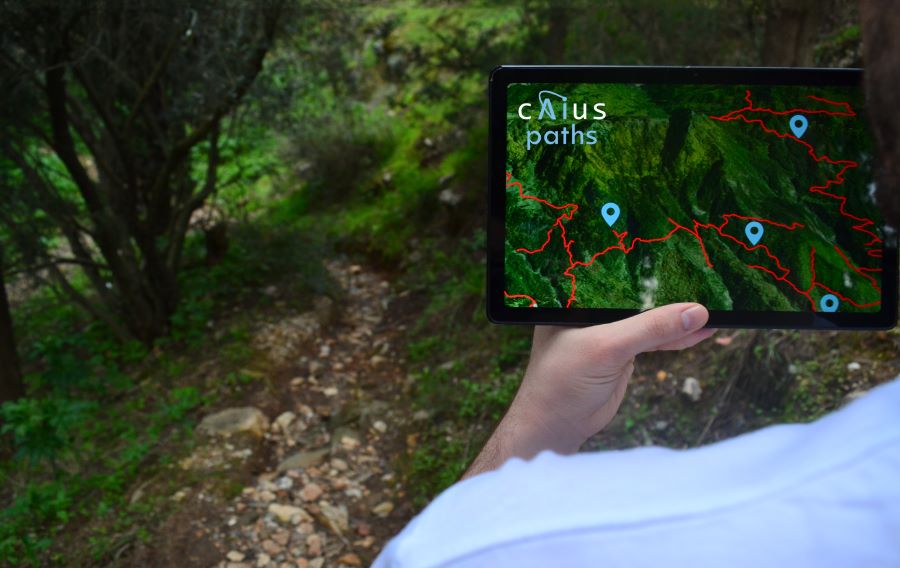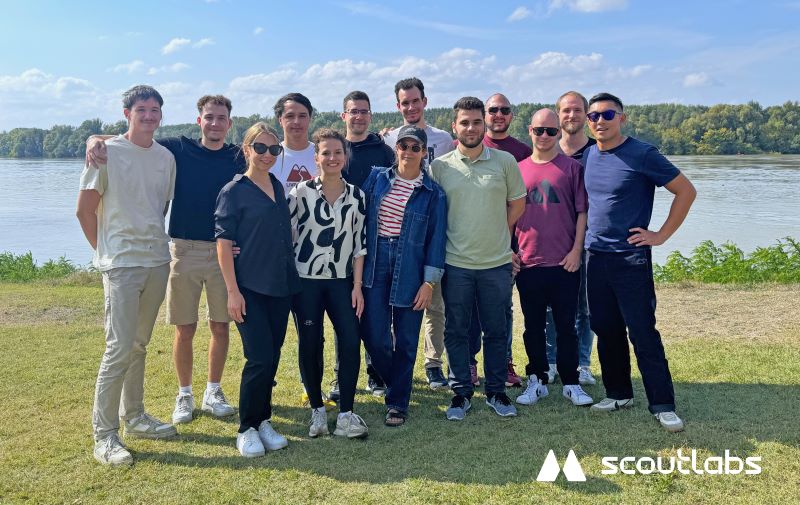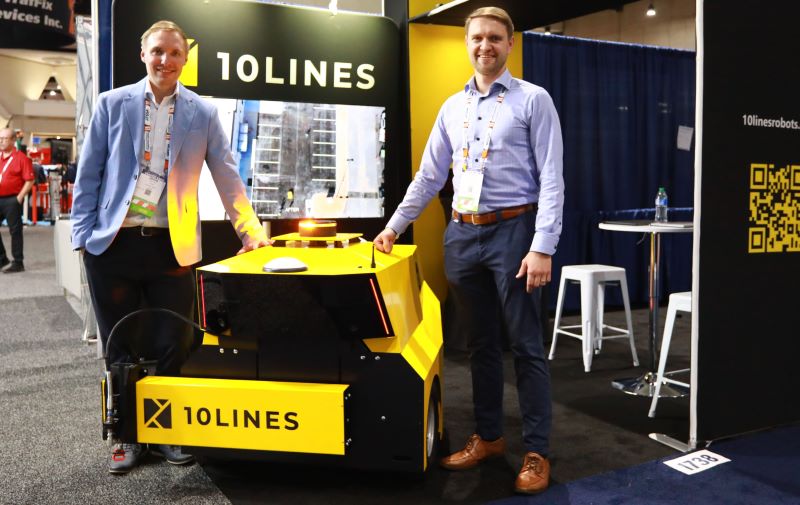Over 30 ESA Business Incubation Centres (ESA BICs) across Europe have supported more than 1,450 start-ups for the past two decades. These companies are active in both downstream markets – i.e. the use of data and space technology down here on Earth in virtually any market imaginable -, as well as in upstream markets – i.e. the in-space and in-orbit market sector.
In this article, we present three success stories from start-ups that were supported by the ESA BICs programme. The focus is on the downstream business sector, where these companies exemplify how business and space can foster innovation for the benefit of the whole European ecosystem.
Caius
Founded by Georgios Michas, Georgios Mendrinos, Petros Efstathopoulos, and Efstathios Efstathopoulos in 2022
Alumnus of ESA BIC Greece

Caius is an AI start-up specialising in the use of satellite imagery and geomorphological data to analyse forest areas and natural systems. The company’s innovative AI products automatically digitise forest roads and trails, facilitating the organisation of hiking networks and the planning of emergency routes. Additionally, Caius identifies natural patterns such as vegetation and hydrographic networks while providing 360º digital coverage of both indoor and outdoor spaces to support ecotourism and environmental protection.
To gain more insight into Caius’s technology and its applications, we conducted an interview with a representative from the company.
Q: For your technology, you bring together Artificial Intelligence with satellite and geomorphological data. How did you identify the need for your technology?
A: As researchers in artificial intelligence and passionate hikers who enjoyed exploring new trails and forests, we identified a significant gap in the global ability to automatically map rural areas. Our personal experience revealed the lack of automated systems to efficiently map features like forest trails and other natural elements in these remote regions. The initial opportunity we saw was in mapping hiking trails to create organised hiking networks, herding routes, as well as intervention and escape routes for natural disasters. This solution quickly gained interest from sectors such as regional governments, municipalities, NGOs, forestry departments, and fire services. These then evolved into B2B/B2G clients for our first product, “caius paths”.
Q: How does Caius help with the challenges faced by people in rural areas?
A: Hiking tourism offers a valuable source of income for small rural communities, extending the tourist season without overburdening local residents or the environment. We help these communities by developing hiking networks and introducing scalable technological solutions, such as digitised herding routes, modernising their working environments and attracting younger generations. This approach fosters collaboration in protecting natural and cultural heritage while improving emergency preparedness. With enhanced land digitisation, communities gain clearer insights into their territories, enabling them to plan for growth and address issues like trail maintenance and prevention of natural disasters or new opportunities for ecotourism.
Q: Earlier this year, Caius completed the incubation at ESA BIC Greece. What are your biggest learnings from your time at the incubator?
A: Our participation in the ESA BIC incubation programme provided a valuable opportunity to connect with the broader European space sector, especially with downstream hardware providers, enhancing our product development. We successfully overcame the challenge of transforming a research project into a commercially viable product, securing our first large-scale orders during the programme. The key lesson learned was the importance of networking to understand market needs and offer realistic, impactful solutions. With the programme’s mentorship, Caius also advanced its product to a significant Technology Readiness Level (TRL) 8.
scoutlabs
Founded by Donát Posta and Jimmy Fong in 2022
Alumnus of ESA BIC Hungary

scoutlabs is transforming pest management with the world’s most affordable and dense digital trap network. Their Internet of Things (IoT) devices capture daily high-resolution images of insect pests, analysed by AI and entomologists to provide precise pest pressure alerts. This allows farmers to reduce pesticide use by over 10 times, preserving crop yields and protecting beneficial insect populations. With a subscription model lower than the cost of manual monitoring per growing season per trap and an easy DIY setup, their solution is accessible and scalable.
To understand the space connection of scoutlabs’ product, we interviewed a representative from the company.
Q: With your traps, you want to help farmers combat insect pests. What is your product’s space connection?
A: scoutlabs uses satellite data and space technology to create advanced insect pest traps for farmers. By combining IoT sensors with Earth Observation data from satellites, we can monitor pest populations and environmental conditions in real-time. This space connection allows us to provide highly accurate pest predictions, helping farmers optimise their pest control strategies and reduce crop losses.
Q: The world’s changing climate is bringing new challenges in agriculture. What is scoutlabs’ role in the face of these issues?
A: Climate change is significantly altering agricultural ecosystems, making traditional pest control methods less effective as pests migrate to new areas and change their behaviours. scoutlabs’ role is to provide farmers with the tools they need to adapt to these changes. Our technology enables farmers to act proactively, minimising the impact of emerging pest threats and reducing the need for chemical pesticides, which can harm the environment.
Q: You recently completed your incubation at ESA BIC Hungary. How did you find your way to the incubator?
A: We found our way to ESA BIC Hungary through our desire to integrate space technology into agricultural solutions. ESA BIC’s focus on fostering innovative space-based applications made it the perfect incubator for us to develop our technology further. The biggest takeaway from our time at ESA BIC Hungary was the importance of collaboration and access to cutting-edge space technology. The support from ESA BIC Hungary also helped us navigate the challenges of integrating space data into agricultural practices, making our product more robust and effective for farmers facing the challenges of a changing climate.
10Lines
Founded by Janno Paas and Tarmo Prints in 2019
Alumnus of ESA BIC Estonia

10Lines develops pavement marking solutions. A 10Lines robot stripes a parking lot 7 times faster than the current methods. In addition, one robot saves about 2 tons of CO2 per year.
To gain a deeper understanding of 10Lines’ journey and the inspiration behind their technology, we spoke with a representative from the company.
Q: You are originally from the parking lot marking industry. What is your space connection that brought you to ESA BIC Estonia?
A: 10Lines robots use satellite positioning as one of the main technologies to get the location and provide the quality of striped lines. At the time we applied to ESA BIC we were just looking into different potential products to use to get the needed accuracy (under 1cm). As we are providing a much needed innovation we thought this would be a very good collaboration opportunity.
Q: What were some key takeaways from participating in the incubator?
A: We achieved exactly the result we were looking for. We selected the products that we needed and achieved the accuracy. We got more understanding of the space ecosystem and now we are starting a new project with ESA to research about the Earth Observation data and how we could use it in our solution to make it even more scalable. We definitely recommend participating in the incubator as you get some connections that you otherwise couldn’t get and also new ideas along the way.
Q: You already have robots serving clients in Estonia and the US. What are your next steps with 10Lines?
A: We are currently working on scaling on the US market where we already have people working to make that happen. We are also researching state-of-the-art methods to innovate in the industry. Our mission is to revolutionise the pavement marking industry with our AI-powered technology, which is easy to use and more precise than current manual methods. With this we can increase our clients’ efficiency.
This article was written for the occasion of the 20 years anniversary of ESA BIC in Europe.
For the full overview of this celebration, go to the LinkedIn group by clicking on the button below.